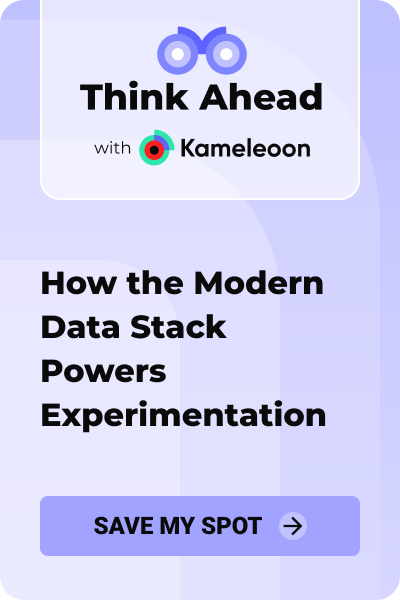
7 of the biggest mistakes companies make when it comes to growth
Growth is such a broad topic, and how it’s achieved varies a lot from business to business. So we asked leaders whose jobs involve growth across product, marketing, and experimentation to share what they think companies often get wrong. And as it turns out, some common mistakes can strike, no matter your strategy.
Here are the seven big mistakes companies make when it comes to growth.
1. Lack of a shared vision & common goals
Poorly put-together vision statements (those wishy-washy ones that say nothing of substance) do little to align teams. But when companies get it right, a corporate vision can guide teams across all functions and help them make decisions. The vision is a reference point for all subsequent goals and metrics, so it really can impact a lot. Pankaj explains the consequence of not having shared goals for growth;
If accountability for growth is isolated to one team, other teams will justifiably prioritise their own goals. This leads to multiple teams trying to negotiate partnerships and support for their respective agendas. The situation often gets resolved with leadership influence, rushed cost-benefit analysis, etc. However, a lot of time is lost to these discussions, which could have happened from the start!
Matthias also discusses the importance of a company vision in promoting a growth mindset and provides suggestions on how to create one;
The consequences? Declining productivity, morale, and suboptimal resource allocation. Such disarray obstructs agility, making market adaptation and growth challenging.
The remedy is to create a vision and strategic objectives that encourage innovation, value creation in key channels, and alignment. The objectives should promote design thinking, experimentation, and connecting initiatives to business goals. This approach not only enhances decision-making (enabling the prioritization of the right initiatives at the right time) but also strengthens resource management and boosts agility in the face of market changes.
2. Going too broad before going deep
We have more marketing channels than ever before and thousands of platforms and strategies within each channel. And companies love to jump on new shiny things for fear of getting left behind. This mentality can be a big mistake when it comes to growth however, as Zach explains,
If you’ve seen success with any major channel like Facebook Ads or SEO or influencer partnerships, chances are slim that you’ve completely tapped that strategy. Consider where you can try to double down or even 10X past efforts.
3. An unhealthy obsession with new customers
Many growth practitioners get caught up chasing new customers. But to grow company profits, you must also focus on making more money from your existing customers by encouraging them to spend more or buy more frequently. After all, you’ve already invested time and money to acquire them. Andrew explains why it’s so important to understand the difference between different types of customers,
Andrew Rolf takes it a step further, explaining that you must identify your most valuable customers and monitor their actions. He’s discussing a B2B example, but the same can apply in a B2C context.
4. Using metrics that don’t drive momentum
Business metrics (like vision and goals) dictate the teams' work and priorities—especially when used in performance reviews. This is why your chosen metrics must relate to real growth and aren’t just vanity metrics. Marilyn provides a great example of this:
Instead of focusing on conversion rates, set goals based on volume. Conversion rates can be easily manipulated and may lead to a pursuit of elusive "silver-bullet" ideas. For instance, aiming for a 20% conversion increase can divert attention from generating insights. With less than 25% of tests yielding positive results, relying solely on 1-3 big ideas limits learning and incremental growth.
To optimize efficiency, adopt the 'learn fast, fail fast' approach. This minimizes time wasted on over-proving ideas and enables the accumulation of wins over time. By rapidly learning how customers interact with the business, the growth team enhances the program's potential for success.
5. Treating growth like a hard science
We all have our own ideas on what we think will work (or not) when it comes to growth. The problem is gut instinct tends to yield poor results. Instead, you need to use data to inform your decisions. But as Shana discusses, don’t make the mistake of thinking you work in hard science.
As a result, growth teams often fail to look at other ways of gathering data about their customer, such as those used in the social sciences. For example, copying anthropologists who practice participant-observer-based studies or doing open-ended surveys and interviews like a sociologist. More observational studies, quantitative driven studies can open up whole new directions of what to test, and eliminate dead ends that are linked to growth by the numbers, but in testing, fail.
6. Not doing the most impactful work in the most impactful places
Growth requires many skills, but one of the most important is prioritizing the highest-value activities to focus on. No matter how big your team is, you can never do everything—and as Zach pointed out above, you shouldn’t be trying to. So prioritization is critical, but it’s not the easiest of tasks. Beth shares why;
For example, basically, every startup needs new customers, but if you spend all your time looking at acquisition, you still might not be growing, even if new people are coming through the door.
Are they activating? Are they getting to a habituation point? Are they churning right away? Until you fix those points further down the funnel, you'll never find Product Market Fit, and all you're doing is filling up a bucket full of holes.
7. A failure to truly understand your customers
It’s easy to think we understand our customers but sit in any user research session, and you’ll quickly realize you don’t. For a start, you’ll be way too close to the business to experience how new customers see your brand, products, or services for the first time. So rather than fall for this mistake, get to really know your customers. Here’s some food for thought from Alexander:
1. Speak to potential and existing customers to confirm this assumption.
2. Understand their buying cycles and time to purchase.
3. Align revenue forecasts to account for short and long-purchase paths based on whom you've chosen to target.
4. Allocate budget according to business needs, but wherever possible, focus on the long term.
Stefanie shares why thinking we understand our customers (without really understanding them) makes us pushy. She rightly warns about using frameworks as gospel rather than guides,
The fact is buyers dictate how and when they buy, and most of that is done online. So it's more about ensuring you have valuable content that helps them in THEIR buyer journey. And given the number of people typically involved in most buying decisions, you can't just focus on one persona or a linear journey. Trying to scale at speed without understanding these basics just layers on bad practice over bad practice.
Finally, Désirée shares that things go wrong when growth only benefits the company and not the customer. Désirée provides a great example of why it’s so important to put your customers front and center when pursuing growth;
But most companies have a misalignment between the customer journey and the value ladder of the product. Businesses need to create a journey that allows the customer to experience a series of products or services that are progressively more valuable, with each step building on the previous one.
Businesses struggle to focus on growth while continuously adding value for customers and assisting them to experience, consume and benefit from that value faster.
Top 7 mistakes businesses make when it comes to growth
Love a cheat sheet? Here’s a handy summary of the top mistakes businesses make when it comes to growth.
- Lack of a shared vision & common goals.
- Going too broad before going deep.
- An unhealthy obsession with new customers.
- Using metrics that don’t drive momentum.
- Treating growth like hard science.
- Not doing the most impactful work in the most impactful places.
- A failure to truly understand your customers.
Thanks to all the growth leaders who provided input for this article. To learn more about how teams are coming together to drive growth cross-functionally, check out our webinar with top voices in PLG.













